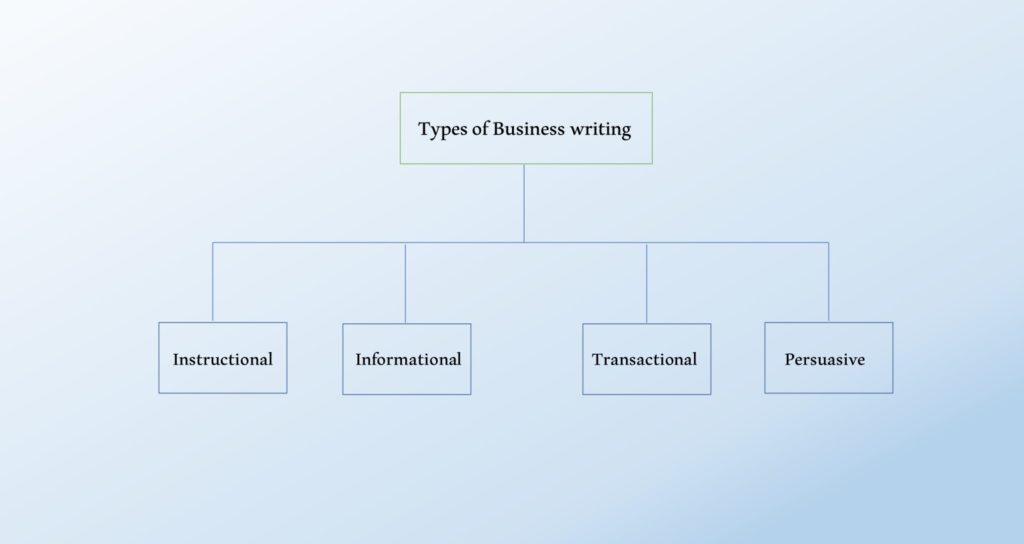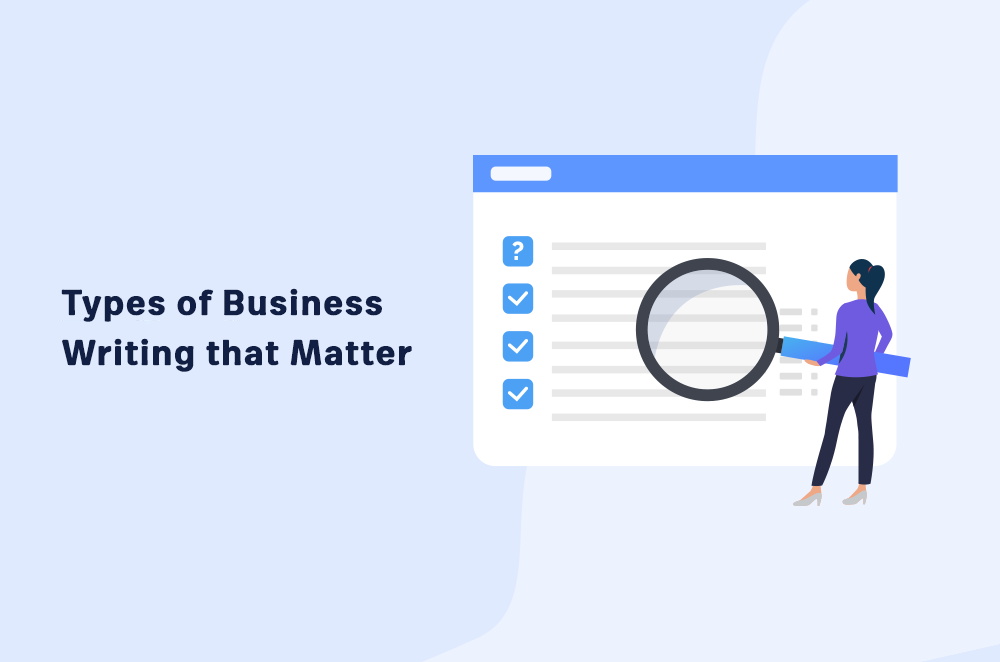Effective business writing is only possible if you understand its different types based on the intention. Written business communication always follows a set of principles that differ according to the four categories of business writing.
That is why not all business documents follow the same tone and format. The writing style adapts according to the document and business communications intentions.
To better understand how to differentiate these business writing styles, you should learn about the four types of business writing.
In this article, we’ll go over the different types of business writing, along with some examples of them to help you understand better.
Let’s get right into it.
4 Types of Business Writing

There are four business writing types that each have their own business writing style and ton specifications. All forms of business writing come under these four categories:
- Instructional Business Writing
- Informational Business Writing
- Transactional Business Writing
- Persuasive Business Writing
While some business writing examples can overlap among these categories, it’s still important to understand how to differentiate each business document.
Instructional Business Writing
Instructional writing entails any form of business writing that involves providing readers with step-by-step instructions and information.
Those instructions can be for completing a task, for attending an event, or for any other purpose.
This form of writing isn’t limited to a time frame. It may be for an immediate task or for future reference.
As it’s a form of written communication, it needs to have a semi-formal or formal tone. It may also involve recording business information accurately to make sure you provide the right instructions.
It’s especially important to take notice of that if your instructional writing is for more than one reader.
In any case, the business document breaks down into steps that are easily understandable. The idea is to communicate with the reader as simply as possible.
Furthermore, you have to make sure that the business documents account for the target audience’s knowledge. On top of that, you have to take potential issues into account too.
Examples of Instructional Business Writing
Instructional writing examples can range from simple instruction guides to complicated and long manuals. However, the common theme is that they always provide instructions and a how-to guide.
The following are some common examples.
- User Manuals – A user manual is a guide for customers that help them understand how to use the product. While user manuals may come under technical writing, they can count as business writing too in some cases.
- Business Memo – Memos are internal communication tools that help share a notification or information within a group or department. For example, the human resources department may update each employee on a policy change using business memos.
- Specifications – While this is a technical document, it can act as an outline for business processes too. It helps the reader understand how a process works.
Other examples can be knowledge base libraries, guides, training materials, how-to articles, on-board instructions, and web copy.
For effective communication, use bullet points, write concise sentences, and treat instructional documents as resources.
Informational Business Writing
Informational writing is all about sharing relevant business information with all stakeholders. It usually acts as a point of reference, especially for certain actions.
Since it acts as a reference or record, it’s an essential part of every business.
It’s important to record all business information accurately. On top of that, consistency in the format, tone, and templates is also important.
Furthermore, it can also include compliance with contractual and legal obligations. Any relevant information that can act as a reference or assist in business actions can come under informational business writing.
Since informational business documents contain valuable information, they have additional security and encryptions.
Examples of Informational Business Writing
Informational writing examples can range from meeting agendas to employee letters. The point is to maintain company information in the document.
The following are some common examples of informational documents:
- Business Reports – A business report can be about company financials, marketing performance, or any other business function. Each element of a business report like the executive summary table requires excellent business writing skills. Organizations use reports to make key decisions, record performance, and provide recommendations.
- Meeting Agenda – Meeting agendas are summaries of meetings to help employees understand what they’re walking into. It’s also a record of decisions, discussions, and assignments for all attendees and the person leading the meeting.
- Financials – These include most financial documents and provide a fiscal outlook of the company.
Other examples of information writing can be white papers, conference papers, employee handbooks, quarterly reviews, educational material, and other documents in a professional setting.
It can also include an employee’s resignation letter or things like a generalized sales message.
Transactional Business Writing
Transactional writing usually includes any kind of daily business communication. That may be internal or external communication.
Today, the most common kind of transactional writing is through emails. However, it also includes official letters, invoices, forms, and other communication documents.
It’s easy to upskill yourself in transactional writing since it’s one of the simplest forms of business writing. There are plenty of online courses you can take to improve.
You’ll get the best value from courses that focus on a single form of writing like emails.
Transactional documents can include any document that helps progress basic company operations.
They’re also the right tool to convey good or bad news to employees.
Examples of Transactional Business Writing
Transactional writing includes all correspondence documents within an organization. However, the following are some common examples.
- Emails – The most common transactional writing happens every day through emails because it’s a quick and convenient way to communicate among staff and clients.
- Business Letters – A business letter can be anything from a hiring letter to a promotion letter. These can include any official letter that an organization creates.
- Contract Documentation – These documents make contracts official by getting the signs of the relevant parties.
Other examples of transactional business writing can include invoices, recipes, handouts, and checkout docs.
Persuasive Business Writing
Persuasive writing is any form of document that aims to push the reader towards an action. That may be to sway their opinion or have them do something.
For the most part, any business document regarding sales can be part of persuasive writing.
However, any writing that is direct, focuses on a single item, and aims at building a relationship can be persuasive writing.
There are always two goals of persuasive business writing — one is to convey information to the readers and the other is to convince the reader of something.
Most persuasive writing aims to assist readers in their decision-making process. That’s why some people tend to put business reports in this category too, especially if the reports include recommendations.
Examples of Persuasive Business Writing
Most persuasive writing examples can overlap with other types of business writing. However, the following are some common persuasive writing examples that strictly fall under this category.
- Business Proposals – A business proposal includes an array of documents that outline an offering of products or services. Most proposals target specific clients. Business proposals include a project overview, costs, timeline, benefits, and competency outlook.
- Press Releases – A press release is a document for the media and journalists that provides them with company information. The idea is to persuade the reader to share the news in their channels.
- Marketing Content – All forms of marketing content can be part of persuasive business writing. That includes everything from the website copy to the ads you run.
Other examples of persuasive writing include sales emails, grant proposals, product copies, banners, and flyers.
Wrapping It Up
Being good at software like Microsoft Excel or Word doesn’t make you good at business writing. That’s because there’s more to it like certain formats, tones, and templates when it comes to business documents.
For a complete understanding, you should start by being able to differentiate among various types of business writing.
Then, you’ll feel positive about your business writing skills. After that, keep on practicing, take some online courses, and learn from your peers.











